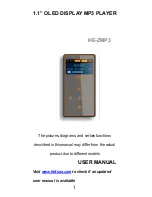
ENGLISH
OPERATION MANUAL
JB SYSTEMS
®
4/82
USB1.1 Mk2
3. USB 1 connection:
this is the first (type-A) USB-connection, used to connect any USB mass storage
device that was formatted in FAT or FAT32. By default this input is used to connect an occasional USB-
drive like USB-sticks etc.
4. USB 2 connection:
this is the second (type-A) USB-connection, used to connect any USB mass storage
device that was formatted in FAT or FAT32. By default this input is used to connect a hard disk.
5. UNBALANCED AUDIO output:
Output for the audio signals from the player. Use the supplied
cinch/cinch cable to connect this output to a CD/line input of your mixing unit.
6. BALANCED AUDIO output:
the same audio signal as on the cinch outputs (5) but balanced output via
XLR-connectors. To be used in case of long audio lines: use optional good quality XLR/XLR cables for
optimal performance!
7. MAINS input:
connect the player to the AC mains, using the supplied power-cord.
8. IR-receiver:
make sure that this IR-receiver is not covered, otherwise your wireless remote will not work
properly!
9. JOG WHEEL:
This jog wheel serves 3 functions depending on the mode you are working in.
The jog wheel acts as a slow frame search (1/75sec) control when the CD is not playing but either
paused or set to a cue point. To set a new cue point, spin the wheel then press PLAY or LOOP IN
when you have determined the proper pos
ition. Press CUE to return to the “CUE POINT”.
If the track is playing the jog wheel temporarily bends the pitch of the music by rotating the wheel
clockwise to speed it up or counterclockwise to slow it down. The amount of pitch change is
determined by the speed of rotation.
During DATABASE lookup mode, the jog wheel is also used to browse the tracks at high speed.
10. LOOP IN button:
Allows you to set the cue point without stopping the playback (CUE ON THE FLY).
This button also sets the beginning of a seamless loop.
11. LOOP OUT button:
Used to set the endpoint when looping music. The player starts to loop seamlessly
until you press this button again to exit. When a loop is programmed but not active you can also restart
the loop. The point where you press the button will be memorized as the new end point of the loop. In
loop edit mode pressing the OUT button stops the loop editing and saves the new loop endpoint.
12. RELOOP/STUTTER button:
This button has 3 functions:
RELOOP:
When a loop was programmed and you have hit the OUT button, press the RELOOP
button to enter the loop again. To exit the loop press the OUT button. (begin and end points of the
loop are unchanged)
STUTTER:
When a loop is playing you can press this button to restart the loop at once. You can also
press this button when a track is not playing in loop. Every time the RELOOP/STUTTER button is
pressed, it will restart the music from the preprogrammed cue point. The stutter effect adds extra
creativity to your performance.
ENTER EDIT LOOP MODE:
When a loop is programmed (LOOP IN and OUT/EXIT buttons are on)
you can enter loop edit mode by pressing the RELOOP/STUTTER button until the display shows the
time of the current loop endpoint: use the JOG-WHEEL to adjust the endpoint.







































